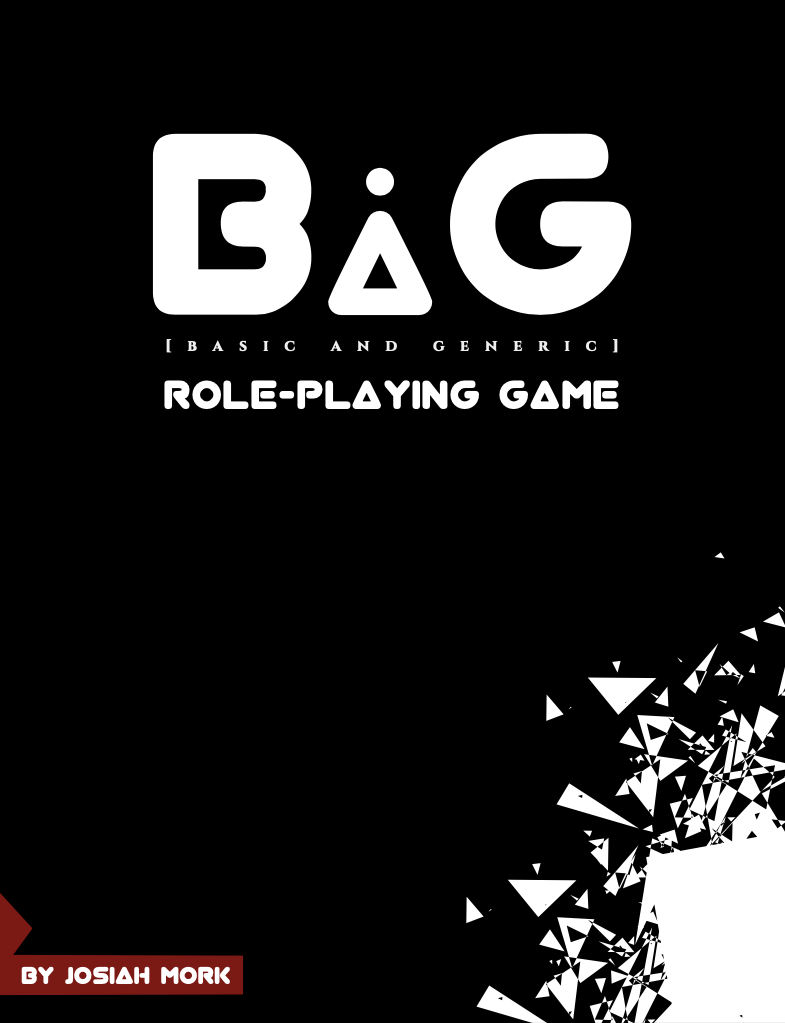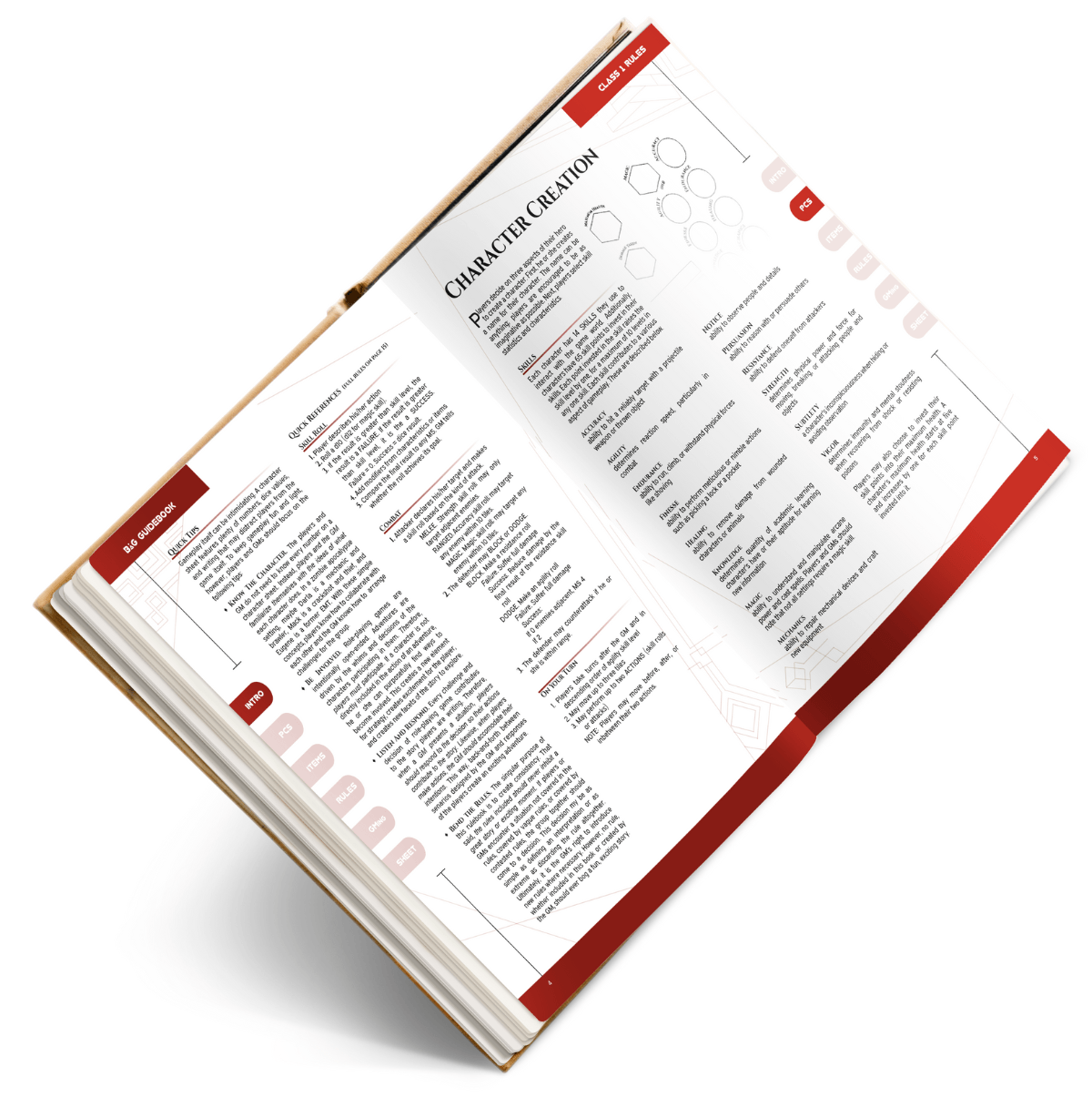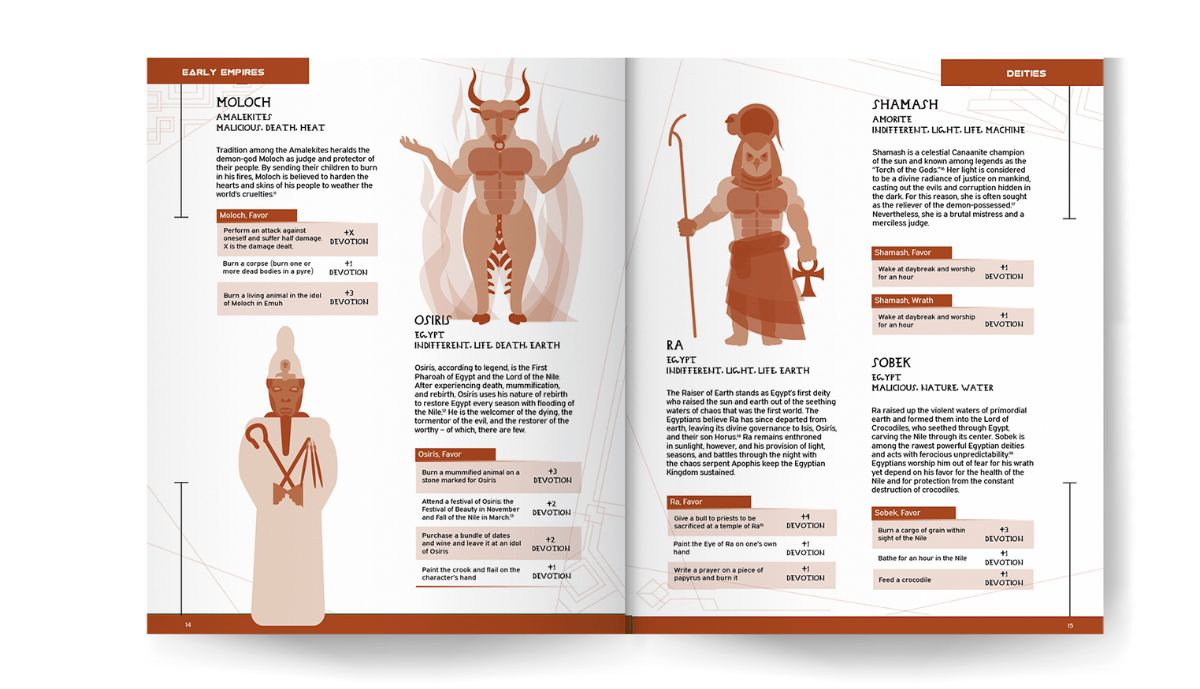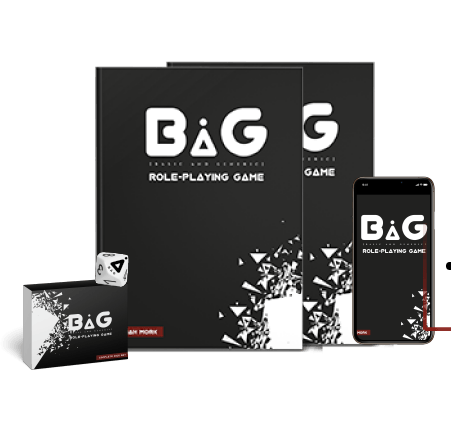BaG (Basic and Generic) Role-Playing Game Review - Score: 79 / 100
This review is part of my new TTRPGs page, where you can find awesome Games Like DnD that you may never have heard of before. If you're interested in finding a new game to play, check out that article!
BaG (Basic and Generic) Role-Playing Game is a new TTRPG, Kickstarted in 2021. This game is multi-genre, where the game master and players can enjoy massive flexibility in their roleplaying. BaG gameplay aims to be “quick, fierce, and extreme.” Overall, I would say that BaG achieves its goal.
First off, the BaG core rulebook is only 55 pages. I cannot tell you how refreshing it is to pick up a new TTRPG that feels so approachable. I also felt playing the game that actions both took place and resolved quickly, creating a streamlined experience.
The cost of playing BaG is also insanely good value, as the core rulebook PDF sells for only $5. This game was created by a college student, with college students in mind. So, if you’re curious to try out a new TTRPG, the barrier to entry here is extremely reasonable.

BaG RPG front cover. Image credit to Josiah Mork and BaG (Basic and Generic) Role-Playing Game.
How Unique is BaG: (8/10)
There are many unique aspects to BaG. The game itself doesn’t offer anything earth-shattering in its uniqueness, overall, but what I enjoy is that the game’s designer (Josiah Mork) has provided unique advancements over previous TTRPGs in familiar areas.
Combat – Attacking
When attacking in combat, your attack roll also functions as your damage roll, if you hit. This saves time, and simply makes sense as more accurate attacks result in more damage. I like it. Also, quite unique.
Combat – Defense
When you’re attacked in combat, you can choose to either try and Block the attack, or attempt to Dodge it entirely. I love the active defense the game offers, along with a choice of what you want to do in response to an attack.
Skill Checks
Skill checks resolve quickly. Players have to roll equal to or under their skill level, but they also have to roll above a Minimum Success (MS) value, meaning that players effectively have what I’ll call a “target range” for success. There probably are other games out there that have used a system like this before, but I don’t personally know of them.
Game Scaling
Perhaps one of the things I like most about BaG is that the game introduces itself to you slowly. In the core rulebook, there are Class 1 Rules, Class 2, and Class 3. Basically, as you master each piece of the game, starting with the foundations, more gets unveiled to you. This approach keeps the game simple, easy to learn, and fast-paced.

How Easy is it to Learn to Play BaG RPG: (9/10)
You may not be surprised, after reading that BaG’s rulebook has only 55 pages, to learn that the game is quite easy to learn. The game makes sense, and the rules are laid out in a very clear manner.
Character Creation
There are 3 parts to character-building: skills (of course), characteristics (positive and negative traits, basically), and items. You distribute skill points into 14 different skills, select characteristics that help make your character unique, and equip items to aid your character in combat and other tasks. Overall, the process is very simple.
I did wish that perhaps there were less characteristics offered in Class 1 Rules, as it slowed our gaming group down when creating characters. The reason is that we all felt that we needed to read through all of our options first, before getting started. This is more of a personal preference though, than a critique.
BaG RPG is a classless RPG, which many people find very refreshing. I also think that BaG is one of the rare games that makes for a great classless game.
Gameplay
Most of the game takes place through resolving skill checks. To make a skill check, players roll a d10. If they roll equal to or under their skill score, they succeed. That is, unless they roll too low, and fall beneath the skill check’s “Minimum Success” range which is set by the dungeon master. This system was a touch confusing for about 5-minutes, but very fun and fast-paced once my group understood how it worked.
Magic, Leveling, and More
Each set of Class Rules (1-3) provides a whole new dimension of play to BaG. As I mentioned before, because of this scaled approach, the game felt very easy to jump into. I was surprised to find that character leveling didn’t appear until the Class 3 Rules, and felt perhaps that they could have been present from the very start. But everything else made a lot of sense.
Some Quirks to the Game
The only reason this section didn’t get a solid 10/10 for me is that there are a few confusing elements to the game that make it a touch less easy to learn. Skill checks are a bit confusing at first. You want to roll as high as possible, but not high enough to go over your skill value, but also still high enough to exceed the skill’s MS.
I was also confused to see that there was no cost to items, and no currencies suggested for the game until Class 3 Rules. For that reason and a couple others, it made the game feel like we couldn’t really get started until we reached the Class 3 Rules. If we’re fighting enemies and want to loot them, after all, what are we supposed to do? The game rules do suggest simply making something up. But that didn’t quite feel complete to me.
Again, small criticisms here, as the bulk of the game flows extremely well.
Presentation: (8/10)
BaG looks great. The graphics on the front and back cover, as well as the page borders throughout the text work very well. I like the font choices, colors, and general layout. Very good overall presentation.
When first reading through BaG, I did not realize that there were different Classes of Rules (1-3) which would lay out the game for me in stages. Perhaps I simply missed it when reading through the intro. In any case, the result was that I became confused at a few points early on by questions that didn’t get answered until reaching the Class 2 or 3 Rules.
For example, if you have a 10-sided dice for skill checks, how do you beat Minimum Success (MS) scores of 12-16 to overcome Heroic Difficulty Modifiers? Well, it appears that you can do so with Bonus Dice, which you unlock in Class 3 Rules.
That makes sense to me, and is very cool. I just would’ve liked more of a heads up. Maybe something that said “hey Jacob, if something isn’t clear when you first read it, just wait until Class 2-3 Rules where it will all make sense. Don’t worry. Just keep reading.”
Lore: (6/10)
My original lore rating for BaG was only going to be a 3/10 for the same reasons that I gave in my Savage Worlds review. Basically, the BaG core rulebook provides no lore (since it is multi-genre), and therefore relies heavily – almost exclusively – upon the game master to create a fun world and storyline.
However, I did include the BaG expansions in my overall review – again, because the price of purchase is so inexpensive that they aren’t prohibitive in the slightest for the majority of gamers.
The “Early Empires” expansion is a great. Lots of material here. A fully-fleshed out setting you can use. It features over 40 pages of just maps, along with unique items, historically-accurate deities, laws, and more. I also enjoyed the “Suburb-ville” expansion which gives you more to do in a modern era.
The lore for the BaG expansions is pretty thorough, but I wouldn’t consider it extremely unique. Definitely good material for your game, but it still left something to be desired for me when thinking about how I would game master an entire campaign for this system.

BaG "Early Empires" Expansion. List of Deities.
Combat in BaG RPG: (6/10)
As someone who enjoys power gaming, I didn’t fully love the BaG combat system. It is a good system though, so I want to start with what I liked.
Pros
Combat is fast-paced. Thank you Josiah for making a game where combat is actually fast-paced. Seriously, this seems like it should be a no-brainer, but many, many tabletop RPGs do not hit the mark here (I would even say that Dungeons and Dragons 5th Edition has very slow combat in comparison). So, BaG is refreshing.
Combat is also simple, yet flexible. When playing BaG, I never felt like I didn’t understand what was happening in the battle. Skill checks for hitting and defending keep combat streamlined and simple, and I also found later on with the Class 3 Rules that magic added an entire level of additional depth to the game.
Cons
If you have 5 Strength, you have a 50% chance to succeed on a melee attack (against an MS 0 enemy). The average damage you then deal is 2.5, giving you a total average of 1.25 damage per attack. Following so far? Ok, so if you have 10 Strength, you have a 100% chance to succeed on a melee attack (again, against an MS 0 enemy). The average damage you deal is 5, giving you a total average of 5 damage per attack. See where I’m going with this? The later 5 points of Strength (only doubling your Strength score from 5) quadruples your damage output.
That’s what happens when a game makes your hit chance also create your damage value. Not an issue, really. It is cool, but as a power gamer, I feel like I must have 10 Skill points into combat-related scores, non-negotiable.
I was also surprised that when you cast magic, there seems to be a pretty high MS rating for most spells which often results in low hit chances. Don’t get me wrong – in BaG, you actually create your own magic spells, custom – and I love that. But if you plan to deal a lot of damage as a wizard of sorts, in my group’s experience, you will probably have a harder time doing so than a guy with a sword or gun.
BaG RPG Game “Flow”: (9/10)
There is so much room for player creativity in BaG. I love the crafting system and magic-creation system. I also enjoyed how players’ characteristics helped shape both their skill checks and actual roleplaying.
Skill checks go fast, combat goes fast, and as a result, storylines develop pretty quickly. Our group did have some confusion around Bonus Dice and exactly how it worked, which did slow us down a bit.
I love the specialization potential that Bonus Dice provide characters, but the extra rolls/ checking results did feel cumbersome compared to the super speed of earlier play. This was another small issue for us, and got better with time. But, I do wonder if there could be a slightly easier way to use Bonus Dice as it definitely didn’t work the way we expected it to.
For example, you do not simply add your Bonus Dice roll to your d10 roll and go from there. Instead, there’s some finesse involved that I’m still not 100% sure I totally get (whoops).

Artwork: (3/10)
With up-and-coming TTRPGs, I never expect too much in the way of artwork. New TTRPGs often can’t afford a professional artist who can create multiple high-quality pieces, after all. BaG did well as a Kickstarter game, but never aimed for high-quality artwork, anyways. I can appreciate that, and the game’s overall experience is certainly good despite the lack of artwork.
Ease of Purchase: (10/10)
BaG is extremely easy to purchase. You can find it on the BaG website, and find information on it at both the BaG Facebook page and Kickstarter page.
Price & How Many Books Do You Need to Play: (10/10)
I love that you can play BaG for only $5 (current price) as a PDF, or $19 in print. Both are extremely reasonable. You also only need the one core rulebook, and the expansions are completely optional.
Ease of Starting a Group & Availability of Supplemental Material: (10/10)
Since this game is easy to get into and covers any genre of tabletop roleplaying you could really ever want, you should have a very easy time getting a gaming group together. BaG is not a famous game yet, by any means, but you can help make it so. My gaming group enjoyed playing, and almost everyone in my group has played multiple game systems before. So, I can confidently say that chances are good your players will have fun, as well.
Also note that BaG does have expansion settings with “Early Empires” and “Suburb-ville” that provide all kinds of additional material your group can use in an ongoing RPG campaign.
BaG (Basic and Generic) Role-Playing Game is Produced By:
Josiah Mork
Dice, Dungeons, Games & More - Eternity TTRPG
Share This Article

Author - Jacob Tegtman
Dear reader, I hope you enjoyed this article. Tabletop gaming has been a passion of mine since I was 6 years old. I've played just about every game from Dungeons and Dragons to video games like Final Fantasy. These games have inspired me, made me laugh, made me cry, and brought me endless hours of enjoyment.
I started Eternity TTRPG - and the indie tabletop game that goes along with it (Eternity Shop) - to share my love of gaming with others. I believe that in our technology-driven age, tabletop games help bring a sense of magic and community back into our world.
If you love the site, please share it with others! I have lots of gaming-related material for you to peruse and use in your own gaming sessions. If you have any questions about the site or want to contribute, just send me a message using the "Contact" page, which you can find in the site's footer.











